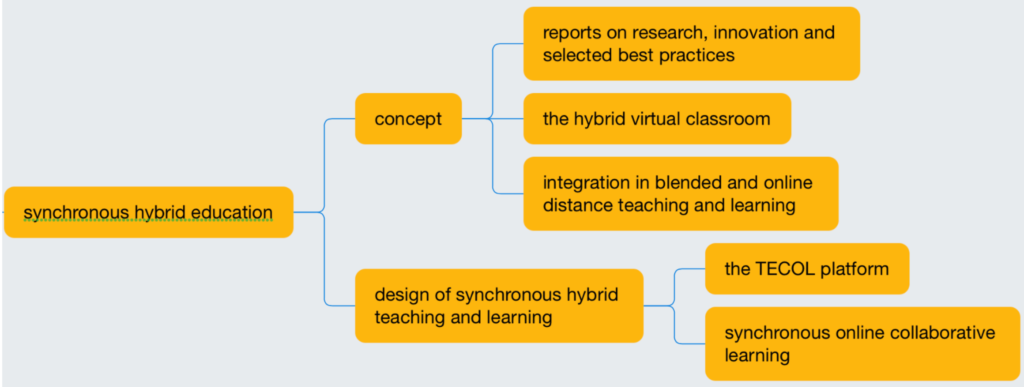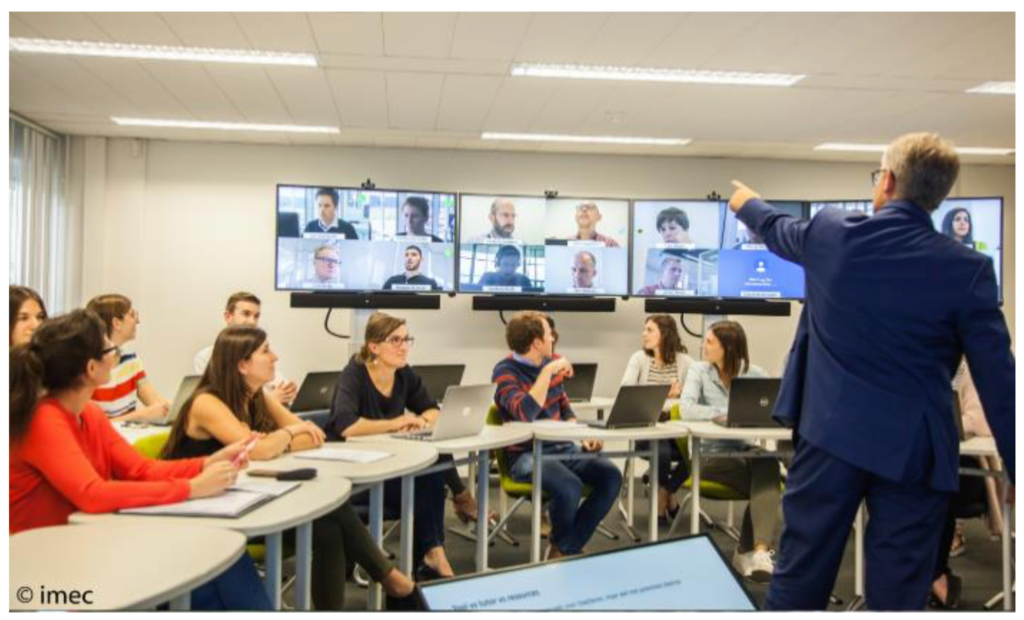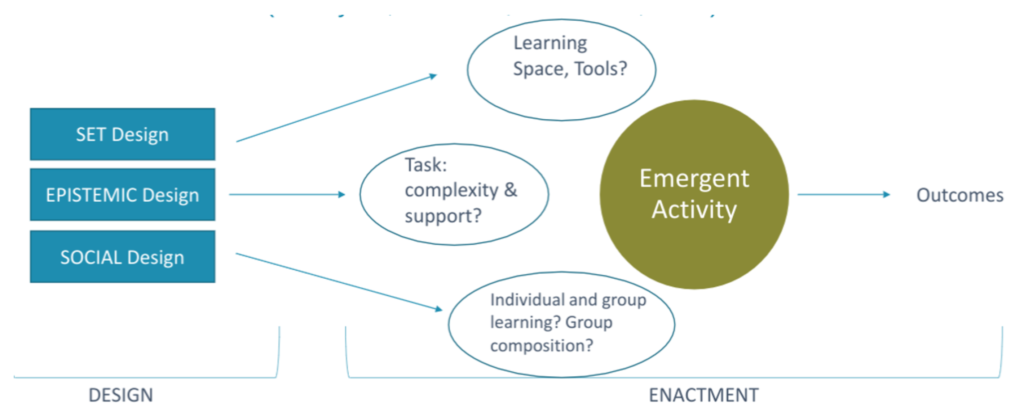
Synchronous hybrid education is rapidly evolving in digital higher education, supported by the latest technologies:
- The concept is explained through reports on research, innovation and selected best practices;
- The hybrid virtual classroom is a strong example;
- Synchronized hybrid teaching and learning can be integrated in blended and online education;
- two design models are presented: the TECOL platform and synchronous online collaborative
learning in hybrid virtual classrooms.
Concept
Synchronous hybrid education is based on settings that have in common that both on-site or ‘here’ students and remote or ‘there’ students are simultaneously included during learning activities (Raes et
al., 2022).
During the COVID crisis, universities could allow only a part of or even no students to lectures, seminars or labs, while others attended online. This is the point where synchronous hybrid education came in. It moved from the periphery to the center of educational practice, combining innovative pedagogies, technology and both physical and virtual space design.
In recent studies, other concepts aside from “hybrid synchronous learning” appeared: hybrid synchronous instruction, hyflex course design, synchromodal learning, synchronous hybrid learning, synchronous online teaching; fusion classroom (Bülow, 2022).
Reports on research, innovation and selected best practices.
In the framework of the DigiTeL Pro project following the COVID call of the European Commission to make universities ready for digital education, the KU Leuven group reported on state-of-the-art research innovation on synchronous hybrid learning:
Raes, A., Pieters, M., Van de Plas, F. (2022), Report on the state of art research, innovation and good
practices of synchronous hybrid learning and conclusions related to the COVID 19 context. DigiTeL
Pro project. https://digitelpro.eadtu.eu/outcomes
The research domain related to synchronous hybrid learning is young, many questions remain open for
further research.
The group has also composed a compendium of best practices at KU Leuven and other institutions:
Raes, A., Pieters, M., Van de Plas, F. (2022), A compendium of selected best practice training materials and/or resources for CPD for synchronous hybrid education. DigiTel Pro project
https://digitelpro.eadtu.eu/outcomes
An earlier meta-analysis of empirical studies comparing distance education with classroom instruction showed small negative effects of synchronous distance education on student achievement (Bernard et
al., 2004). Based on these studies, Daniel concluded “not to waste money on trying to re-create the
impression of live, face-to-face instruction by investment in expensive remote classroom systems for
synchronous instruction. Daniel, 2016)”. This is still a wide-spread perception and actually a misconception as recent studies have shown other results (Raes et al., 2022).
In fact, synchronous hybrid education has become an important pedagogical approach related to current practices in many European universities, triggered by the COVID crisis. New technologies have created and stimulated a new potential for synchronous pedagogies. Many universities have installed video and audio equipment in lecture halls and continue to experiment with more advanced technological infrastructure. Extensive research is now underway, which offers unique solutions compared to video and web conferencing platforms.
The hybrid virtual classroom
An outspoken example of the synchronous hybrid approach is the hybrid virtual classroom, where some students are attending lessons in the classrooms and others attend remotely as individuals, or possibly in a remote classroom in an (international) multi-campus situation. An internet environment is created where staff and students come together simultaneously and can communicate directly with each other via audio, video and chat via to-way media, facilitating dialogue and interaction.
Synchronous hybrid learning platforms offer various presentation and evaluation functions and the
possibility to work in subgroups (Janssen et al.,2020; Janssen and Wopereis, 2020). In synchronous online learning, advantages such as real-time interactions, increased accountability, the opportunity to structure time, and immediate feedback encourage greater student engagement and participation. Its limitations include possibilities of technical issues, scheduling conflicts, and requirements for access to the internet and devices at specific times.
Integration in blended and online distance learning
In many universities, synchronous hybrid learning is adopted as the main approach to digital education. It can also be combined with the other approaches presented here, more specifically in blended and online distance learning courses, for example in open and distance universities. Synchronous hybrid creates then moments of direct interaction in addition to mainly asynchronous teaching and learning activities.
Design of synchronous hybrid teaching and learning
The TECOL platform
With the TECOL (Technology Enhanced COllaborative Learning) project, KU Leuven and industrial partners have developed educational and technological solutions aimed at interactive and collaborative learning (Raes et al., 2020). The emphasis is on development, implementation and research in four major synchronous settings: the interactive lecture, collaborative learning spaces, open learning centers and multi-location learning in remote or virtual classrooms. This responded to the university’s pre-COVID needs as part of a broader institutional strategy: supporting lectures with the best teaching technology available, creating on-campus learning spaces where students could learn on their own or in a group, and simultaneously teaching for classes at multiple locations of the university across Flanders.
The TECOL platform has been developed that can be accessed anywhere, on any device and at any time, working on the “bring your own device” principle. Both teacher and student make a wireless connection to the platform and can continue to navigate through the screens. TECOL plays a mediating role between all actors in the four settings mentioned.

A TECOL White Paper (http://www.kuleuven.be/tecol/whitepaper ) presents a series of principles that
respond to shifts in teaching and learning:
- from receptive to (inter)active learning;
- from individual to collaborative learning; and
- from a single location to multiple locations.
Multi-location learning makes the synchronous hybrid education approach also suitable for multicampus
education, international education and virtual mobility, and for continuing education.
Multi-location learning: remote and hybrid virtual classrooms
In addition to the interactive lecture and collaborative learning space, a main functionality of the TECOL platform is to enable multi-location learning.
Two variants of multilocation teaching and learning are distinguished: the remote classroom and the virtual classroom.
In the remote classroom, two or more groups of students take the same lesson in different locations. Within the TECOL platform, close collaboration was established between the KU Leuven campuses in
Ghent, Bruges and Kortrijk to achieve this optimally.
In the virtual classroom (see Fig. 6) students follow the lesson individually from their own chosen location. They are shown separately on the screens in the back of the room. When students can still choose to take classes on campus, we speak of a hybrid virtual classroom.
The hybrid virtual classroom combines the possibility of face-to-face and distance learning. Within this learning environment, the interactivity of the lectures on campus is preserved and students can ask questions orally, participate in quizzes and polls remotely. Tools for this are integrated.
Learning in multiple locations has brought benefits during the COVID crisis. It is also particularly interesting for, for example, working students, continuing education and professional development in
collaboration with the labor market (enterprises, professional associations and international mobility
of students (remote and virtual classrooms) and teachers (guest lectures/lecture series).
In these settings, teaching is synchronous. The students follow the lesson remotely at the time the
lesson is given. This creates an independence of place, but not of time. The advantage of synchronicity
is that real-time interaction is possible. Flexibility is created by multi-location, but also limited by synchronicity. It can be used in settings where time independence is not required or desired.
Design of synchronous hybrid teaching and learning
For the design of synchronous hybrid learning, the TECOL project took the ACAD framework as a reference framework (fig….) (Goodyear, Carvalho and Yeoman, 2021).
The ACAD framework refers to three design components, which correspond to the types of entities
that can be designed for teaching and learning: the set design (the physical situation), the epistemic
design (the learning tasks: complexity and order) and the social design (the social situation for learning).
The epistemic design of learning tasks may involve determining how information is to be conveyed,
its selection, pacing and sequencing, which will result in instructions. The set design includes considerations about the tools and artifacts made available to students and the space where learning
activity unfolds. Social design involves considerations about how students are socially organized, e.g.
in pairs, groups or follow script roles.

In the TECOL project, diverse scenarios are designed based on this ACAD framework, as “Collaborative problem solving in a synchronous hybrid classroom”; and “Multi access education in the hybrid lecture hall”. Successful teaching and learning activities were developed and implemented based on the set, epistemic and social design decisions (Raes, Pieters and Van de Plas, 2022b).
Student and teaching staff experience
Student evaluations after hybrid virtual classrooms showed that students really belonged to the class, they could easily communicate with the teacher, the hybrid virtual classroom offered more flexibility,
and it saved time. Traditional lectures were no easier to follow than hybrid virtual classrooms. Teachers had the experience as if students were there, some of them at a distance in the virtual classroom. When designing education, they had to prepare interactions to engage students. After a few lessons, they will act more intuitively. The technology helps to create interaction (quiz and poll system). Teachers report little or no differences with traditional education in terms of attention and involvement of students. The challenge for teachers is to properly divide their attention between students in the classroom and outside.
CPD for teaching staff
In the framework of the TECOL at KU Leuven, teaching staff is trained for designing synchronous hybrid teaching and using the technologies (see also: https://edtechbooks.org/hyflex/hyflex_MTP_KULeuven
Research
In the TECOL project, quasi experimental research in authentic educational contexts is done with regard to effective teaching and learning scenarios in synchronous hybrid learning. Main themes are:
- the place of group work in the instructional process
- support of group work within collaborative learning spaces
- the use of quizzes and polls and the effect on student engagement
- optimal instruction in multi-location learning
Synchronous online collaborative learning
The design and development of synchronous online collaborative learning
The Open University of the Netherlands developed an e-handbook on the design and development of synchronous online collaborative learning in the framework of a SURF project on Synchronous Online
Education (BISON) (SURF, 2022; Janssen & Wopereis, 2022). This was also based on dimensions in the comprehensive framework for the design of group learning activities in higher education of de Hei et al. (2016).
Synchronous online collaborative learning is for example practiced in virtual classrooms. Students are
‘physically’ separated from each other during a session, but connected via a computer network. Participants can communicate and interact with each other in real time via audio, video and chat,
enabling interaction and dialogue.
The handbook presents guidelines, detailed examples of pedagogical scenarios and best examples.
Three scenarios are presented: the problem-based, case-based, and project-based scenarios, also for
use in a hybrid virtual classroom as defined above.
Example: multi-step problem-based scenario
During a multistep problem-based learning task (PBL), groups of students solve a problem step-bystep. Each solution step is discussed in plenary. The multistep PBL is intended for learning how to solve complex problems. It can also be used to learn how to analyze or evaluate complex procedures and protocols step-by-step in group. The method falls under the heading of collaborative problembased
learning (CPBL).
The multistep PBL is a teaching method in which restrictions are imposed on the behavior of students:
students are only allowed to take the next step once previous steps have been understood. This coercive form of supervision is also known as ‘performance constraints’ (van Merriënboer & Kirschner, 2018).
Detailed guidelines are given for each of the design building blocks for multiple PBL (Wopereis, Janssen & Van Wijnen, 2021. See also: de Hei et al., 2016):
- Specify learning objectives:
Describe the learning objectives and content: subject-specific knowledge, skills, scope; the balance between (individual or group) self-regulation and instruction planning; specify timing of learning objectives (fixed, flexible). Reflection on learning objectives goes hand in hand with reflection on the interaction. - Specify activities:
Specify the activities that the students must perform in order to achieve the learning objectives and the possible phasing in these. Collaborative learning formats consist of activities (complex tasks) that in principle a student cannot perform alone: describe the type of activities; balance learner-teacher control; sequence the activities; specify the duration and frequency of collaborations. - Specify supervision:
The supervision can be performed by different actors, the teacher can fulfill different roles during the supervision process, the way of communication can vary and the duration and timing of the supervision can vary: determine who is performing the supervision (teacher, peer students, technology); describe he role of the teacher during supervision; describe the way of communication (web conferencing, audio, chat); determine the duration and timing of supervision (continuous, fixed moments, on demand); - Specify interaction:
Interaction during collaborative learning has a content component and a structure component. The content of the interaction and focus for supervision is strongly related to the learning objectives.
The structuring of interaction influences task performance. It creates interdependence within the group and encourages individual responsibility for learning: the interaction is mainly related to acquiring subject-specific knowledge and/or skills, monitoring task performance (regulation), functioning of the group (social skills); explain the content of the interaction; prestructuring dependencies: reward-dependence (the evaluation is (partly) based on the group result, not on the individual performance), task-dependence (to complete the task, input from each group member is necessary) or no dependencies.
Structuring during the collaboration: the teacher monitors the task performance and intervenes
if necessary (e.g. feed up, feedback, feed forward; both corrective and cognitive), or the teacher or software provides collaborative self-study materials (e.g. tutorials, FAQs); structuring after the collaboration: students reflect on learning domain-specific knowledge and skills. Have the learning objectives aimed at this been achieved? (evaluation), and students reflect on the cooperation in the group. - Specify assessment: Think about how it is determined whether (and to what extent) the learning objectives have been achieved. Indicate which resources (instruments, procedures) you will deploy and on the basis of which criteria the assessment will be made. More specifically, this involves thinking about: (a) goal, (b) level, (c) assessor and (d) task. Determine the purpose of the assessment: improving/strengthening knowledge and/or skills (formative), or whether a student is allowed to continue or not (‘pass/fail’; summative). The level of assessment: the individual student, the group result. Indicate who the assessor is: peers (co-assessment, peer-assessment), the student (selfassessment); the teacher. Determine the number, timing and integration of assessments: multiple assessments spread over time, or assessment on large units of learning (e.g. “the whole task”).
- Specify group composition:
Design decisions related to group composition are about (a) the number of groups and group
size, (b) criteria for group composition, (c) and how long a group forms a unit:
Decide by whom groups are formed: the teacher, the students themselves; the software (‘at
random’ or by registration).
Determine on the basis of which criteria groups are composed: characteristics independent of
the task: (age, gender, friendship, place of residence), task-relevant criteria (behaviour, products from previous phases of collaborative learning); coincidence (at random).
Decide on the duration of the composition of the groups: does not change during the task, changes after a certain time and/or step in the problem-solving process. - Specify facilities:
Facilities mean all resources that support group learning activities. They relate to (a) learning
environment, (b) technology (tools, media) and (c) the time frame in which the assignment must be carried out.
Wopereis et al. developed also guidelines for case-based and project-based scenarios (Wopereis, Janssen & Van Wijnen, 2021)
next chapter: Blended teaching and learning
previous chapter: Basic concepts in digital higher education
back to overview: Models and guidelines for the design and development of
digital teaching and learning in higher education
